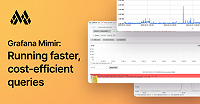Important: This documentation is about an older version. It's relevant only to the release noted, many of the features and functions have been updated or replaced. Please view the current version.
Grafana Mimir production tips
This topic provides tips and techniques for you to consider when setting up a production Grafana Mimir cluster.
Ingester
Ensure a high maximum number of open file descriptors
The ingester receives samples from distributor, and appends the received samples to the specific per-tenant TSDB that is stored on the ingester local disk.
The per-tenant TSDB is composed of several files and the ingester keeps a file descriptor open for each TSDB file.
The total number of file descriptors, used to load TSDB files, linearly increases with the number of tenants in the Grafana Mimir cluster and the configured -blocks-storage.tsdb.retention-period.
We recommend fine-tuning the following settings to avoid reaching the maximum number of open file descriptors:
- Configure the system’s
file-maxulimit to at least65536. Increase the limit to1048576when running a Grafana Mimir cluster with more than a thousand tenants. - Enable ingesters shuffle sharding to reduce the number of tenants per ingester.
Ingester disk space requirements
The ingester writes received samples to a write-ahead log (WAL) and by default, compacts them into a new block every two hours.
Both the WAL and blocks are temporarily stored on the local disk.
The required disk space depends on the number of time series stored in the ingester and the configured -blocks-storage.tsdb.retention-period.
For more information about estimating ingester disk space requirements, refer to Planning capacity.
Ingester disk IOPS
The IOPS (input/output operations per second) and latency of the ingester disks can affect both write and read requests. On the write path, the ingester writes to the write-ahead log (WAL) on disk. On the read path, the ingester reads from the series whose chunks have already been written to disk.
For these reasons, run the ingesters on disks such as SSDs that have fast disk speed.
Querier
Ensure caching is enabled
The querier supports caching to reduce the number API requests to the long-term storage.
We recommend enabling caching in the querier. For more information about configuring the cache, refer to querier.
Avoid querying non-compacted blocks
When running Grafana Mimir at scale, querying non-compacted blocks might be inefficient for the following reasons:
- Non-compacted blocks contain duplicated samples, as a result of the ingesters replication.
- Querying many small TSDB indexes is slower than querying a few compacted TSDB indexes.
The default values for -querier.query-store-after, -querier.query-ingesters-within, and -blocks-storage.bucket-store.ignore-blocks-within are set such that only compacted blocks are queried. In most cases, no additional configuration is required.
Configure Grafana Mimir so large tenants are parallelized by the compactor:
- Configure compactor’s
-compactor.split-and-merge-shardsand-compactor.split-groupsfor every tenant with more than 20 million active time series. For more information about configuring the compactor’s split and merge shards, refer to compactor.
How to estimate -querier.query-store-after
If you are not using the defaults, set the -querier.query-store-after to a duration that is large enough to give compactor enough time to compact newly uploaded blocks, and queriers and store-gateways to discover and synchronize newly compacted blocks.
The following diagram shows all of the timings involved in the estimation. This diagram should be used only as a template and you can modify the assumptions based on real measurements in your Mimir cluster. The example makes the following assumptions:
- An ingester takes up to 30 minutes to upload a block to the storage
- The compactor takes up to three hours to compact two-hour blocks shipped from all ingesters
- Querier and store-gateways take up to 15 minutes to discover and load a new compacted block
Based on these assumptions, in the worst-case scenario, it takes up to six hours and 45 minutes from when a sample is ingested until that sample has been appended to a block flushed to the storage and the block is vertically compacted with all other overlapping two-hour blocks shipped from ingesters.

Store-gateway
Ensure caching is enabled
The store-gateway supports caching that reduces the number of API calls to the long-term storage and improves query performance.
We recommend enabling caching in the store-gateway. For more information about configuring the cache, refer to store-gateway.
Ensure a high number of maximum open file descriptors
The store-gateway stores each block’s index-header on the local disk and loads it via memory mapping. The store-gateway keeps a file descriptor open for each index-header loaded at a given time. The total number of file descriptors used to load index-headers linearly increases with the number of blocks owned by the store-gateway instance.
We recommend configuring the system’s file-max ulimit at least to 65536 to avoid reaching the maximum number of open file descriptors.
Store-gateway disk IOPS
The IOPS and latency of the store-gateway disk can affect queries. The store-gateway downloads the block’s index-headers onto local disk, and reads them for each query that needs to fetch data from the long-term storage.
For these reasons, run the store-gateways on disks such as SSDs that have fast disk speed.
Compactor
Ensure the compactor has enough disk space
The compactor requires a lot of disk space to download source blocks from the long-term storage and temporarily store the compacted block before uploading it to the storage. For more information about required disk space, refer to Compactor disk utilization.
Caching
Ensure Memcached is properly scaled
We recommend ensuring Memcached evictions happen infrequently. Grafana Mimir query performance might be negatively affected if your Memcached cluster evicts items frequently. We recommend increasing your Memcached cluster replicas to add more memory to the cluster and reduce evictions.
We also recommend running a dedicated Memcached cluster for each type of cache: query results, metadata, index, and chunks. Running a dedicated Memcached cluster for each cache type is not required, but recommended so that each cache is isolated from the others.
Security
We recommend securing the Grafana Mimir cluster. For more information about securing a Mimir cluster, refer to Secure Grafana Mimir.
Network
Most of the communication between Mimir components occurs over gRPC. The gRPC connection does not use any compression by default.
If network throughput is a concern or a high cost, then you can enable compression on the gRPC connection between components. This will reduce the network throughput at the cost of increased CPU usage. You can choose between gzip and snappy. Gzip provides better compression than snappy at the cost of more CPU usage.
You can use the Squash Compression Benchmark to choose between snappy and gzip. For protobuf data snappy achieves a compression ratio of 5 with compression speeds of around 400MiB/s. For the same data gzip achieves a ratio between 6 and 8 with speeds between 50MiB/s and 135 MiB/s.
To configure gRPC compression, use the following CLI flags or their YAML equivalents. The accepted values are
snappy and gzip. If you set the flag to an empty string (''), it explicitly disables compression.


